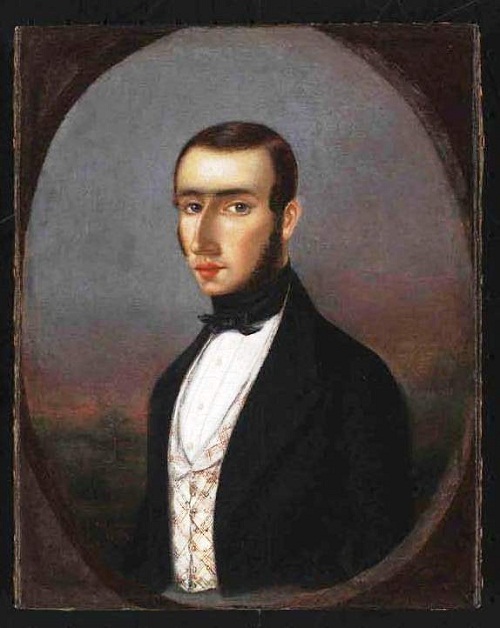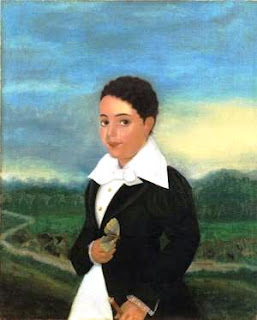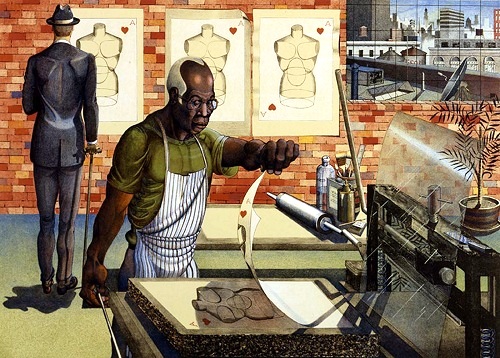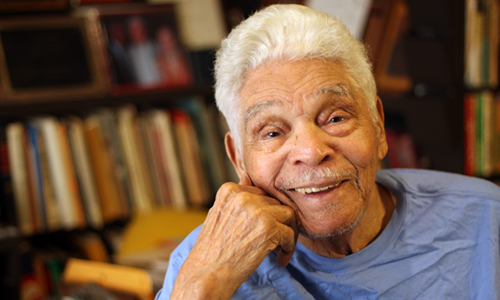 |
| Julien Hudson, Portrait of a Man, Called A Self-portrait, 1839. Oil on canvas. Collection of Louisiana State Museum. |
An art history mystery at Worcester Art MuseumPublished: December 12, 2011
WORCHESTER -- Forget the da Vinci Code. There’s no Knight Templars or murderous albinos, but the life and death of Julien Hudson and the whereabouts of his paintings is a fascinating “art historical mystery’’ waiting to be solved.
The second-earliest documented painter of African descent in the U.S., Hudson was making his mark as a portraitist in New Orleans in the early 1800s before dying of unknown causes, leaving behind just six canvases.
Who was the man with searching eyes in one of his remaining paintings? Did he kill himself, as some suspect? With his sixth painting discovered by a New England collector, can more of Hudson’s valuable works be found in area shops, flea markets or your attic?
An intriguing exhibit, “In Search of Julien Hudson,’’ at the Worcester Art Museum, offers the first retrospective about the man and the artist whose enigmatic career casts light on the lives of free blacks and mixed race people in Louisiana before the Civil War?
Organizer William Keyse Rudolph said, “The search for Julien Hudson isn’t over.’’
“Julien was a very charming painter. He’s definitely important from the historical and biographical standpoint. And he’s definitely part of the bigger story of art in New Orleans on a grand scale,’’ he said.
The former curator of American Art at WAM, Rudolph worked with staff at The Historic New Orleans Collection to include all of Hudson’s known paintings, work by his teachers, contemporaries and student.
Rudolph recently took over as curator of American art and decorative art at the Milwaukee Art Museum.
Subtitled “Free Artist of Color in Pre-Civil War New Orleans,’’ the exhibit, which is making its third and final stop in Worcester, will be on view through March 11.
While comprising about 35 paintings, sculptures, photos and documents, the exhibit opens a revealing window on the little-known communities of free people of color, or “gens de couleur libre,’’ that thrived in New Orleans, Baltimore and Charleston, S.C., between the Revolution and Civil War.
Rudolph said, “For the very first time we’re using Hudson’s life and art to tell a bigger story about free people of color. … It’s fascinating story that a lot of people in the North don’t know.’’
Filling three galleries, the exhibit starts by examining Hudson’s origins, training and striking examples of portraits by other black artists. A small enclosed middle section showcases all the artist’s works and the third section includes work by his contemporaries.
Visitors will see all six of Hudson’s known paintings, distinctive portraits that display the conventions of the era while displaying the stylistic influence of the artist’s two trips to Paris.
In two early paintings of children, “Portrait of a Young Girl With A Rose’’ and “Portrait of a Boy with a Moth’’ from 1834 and 1835, Hudson conventionally put symbolic objects in the children’s hands and places them against colorful backgrounds.
 |
| Julien Hudson, Creole Boy With A Moth, 1835. Oil on canvas. Private collection. |
Four years later, after returning from France, Hudson depicted Jean Michel Fortier — the only portrait in which the sitter is known — as direct and forceful and a bit of a dandy.
Equally fascinating, the show features paintings by other black and mixed-race artists whose portraits often depict people of their community in a surprising new light.
There are several distinctive sculptures by Florville Foy, a free black who was a successful artist, marble cutter and business owner.
For many New Englanders, “In Search of Julien Hudson’’ will provide an exciting opportunity to learn about a vital subculture of the pre-Civil War South that belies some stereotypes and confirms others.
Rudolph explained that Hudson was the mixed-race grandson of a woman who been freed from slavery and the oldest of four children born from the union of Desiree Marcos and Thomas Hudson, an English merchant and ship’s chandler.
From its founding in 1718 to its sale in 1803 to the U.S. as part of the Louisiana Purchase, New Orleans maintained a class of free people of color who were re garded as a “third caste,’’ with a legal and social status that positioned them between the enslaved and free whites.
Hudson’s life reveals many of the possibilities and limitations experienced by free blacks in New Orleans.
Born in 1811, he was initially apprenticed as a teenager to a tailor but after two years abandoned that career to learn to paint the then-fashionable miniature portraits from Italian Antonio Meucci. He later studied under two Europeans with close ties to Paris.
While Rudolph and other art historians have discovered fascinating details of Hudson’s life, the circumstances of his death in 1844 and the whereabouts of whatever paintings he completed during his last decade remain out of reach.
A statement by historian Rodolph Desdunes, who wrote of Creole life in the South, suggested Hudson “preferred to die in misery and anonymity rather than display his talent to the detriment of his self-respect. … It is said that disillusionment cast a cloud of despair over his whole life.’’
Yet Rudolph said no official record lists Hudson’s death in December 1844 or his burial.
Visitors will likely be drawn to Hudson’s masterpiece, an 1839 oil painting of a slim man with sideburns and deep-set eyes sometimes called “Portrait of a Man, Called a Self Portrait.’’ While some claimed it was Hudson, Rudolph said most historians today dispute that claim.
Yet 170 years later, Hudson’s subject —whatever his identity — gazes across the ages reminding us of an artist who remains tantalizingly familiar but forever unknown.
IN SEARCH OF JULIEN HUDSON: FREE ARTIST OF COLOR IN PRE-CIVIL WAR NEW ORLEANS
DECEMBER 9, 2011 - MARCH 11, 2012
55 Salisbury Street
Worcester, MA








































